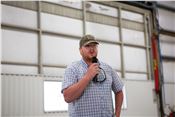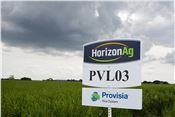Rice Industry Comes Together To Discuss Promise, Challenges
KAPLAN, LOUISIANA
Industry experts and supporters came together recently at the annual Horizon Ag Louisiana Field Day to discuss the promise and challenges of growing rice in 2022 and beyond.
The “promise” is that, overall, the 2022 crop in the Coastal Region is up in acreage and setting up to have good potential at harvest, according to Louisiana Rice Specialist Ron Leavy.
In addition, Horizon Ag varieties PVL03, CLL17 and CLL16 are performing well, and the Provisia® Rice System is again showing its superiority over other weed control technologies in the region.
A challenge is isolated instances of outcrosses in the Provisia system, in fields where the technology has been planted every other year since its launch in 2018. The threat of more resistance developing reinforces the need for good stewardship, best management practices and a concerted effort to protect the effectiveness of the system.
“We have found maybe a dozen or so populations of Provisia outcrosses that are a result of not cleaning up escapes of red rice, and in some cases can be traced back to the first year of Provisia production in 2018 – where we had fields with Provisia rice in 2018, soybeans in ‘19, Provisia rice in ‘20, beans in ’21 and now Provisia in 2022,” Dr. Connor Webster, LSU AgCenter weed scientist, told the crowd of almost 100 in attendance. “We need to make sure we are getting out there and cleaning up misses.”
Another ACCase inhibitor herbicide system, the Max-Ace™ system with Highcard™ herbicide, is reporting even more challenges, according to Dr. Webster. He notes that, unlike Provisia herbicide, Highcard herbicide must have a safener since Max-Acre rice doesn’t have the same level of tolerance as Provisia rice.
“Even with the safener, we are picking up a good bit of injury,” says Dr. Webster. “With a safener in the system, a big question early on was, ‘Is it going to safen on the weed spectrum?’ and the quick answer is yes, to some degree. In my plots, looking at 3, 6, 9, 12 and 15 ounces of Highcard on Max-Ace side-by-side with Provisia rice, the general number is about a 10 percent difference in control. I am having some misses with Highcard in my Max-Ace rice compared to my Provisia rice.”
BASF, Horizon Ag’s technology partner, recently added a three, 10- ounce application approach to the Provisia herbicide label so farmers can choose between that or two applications at 15.5 ounces. “That third application gives you a good way to clean up any escapes,” Dr. Webster says.
Dr. Tim Walker, Horizon Ag general manager, adds that the potential for outcrosses with the ACCase system was always there since the herbicide technology doesn’t provide residual control. Now that the threat is showing up, Horizon Ag is committed to working with farmers to meet the challenge “head-on.”
“There’s no need to stick our head in the sand,” says Dr. Walker.

“We have an issue. Let’s not be dejected about it. If we are going to maintain this technology, we are going to have to think outside the box and use best management practices. We are working with our industry partners and customers and do what we need to do to steward the technology.”
He adds that the Provisia system is still excellent technology, and PVL03 is a very good variety, with high yield potential, milling quality and an industry-leading disease package.
“It’s the best system available today for weedy rice,” Walker adds. “We can’t afford to be safe on weeds.”
LSU AgCenter rice breeder Dr. Adam Famoso told field day attendees that PVL03 has done very well on first- and second-crop production in his test plots over the years, “yielding in the ballpark with our top Clearfield varieties.”
Horizon Ag Clearfield® variety CLL16, an Arkansas-bred variety, is also performing well in Louisiana, although it is a later-maturing cultivar and isn’t the best fit in a ratoon crop system.
The LSU AgCenter and other universities are working with Horizon Ag to examine varieties in different growing environments to determine where varieties might be a good fit. For instance, another Arkansas variety expected to be released commercially next season, CLL18, is a little earlier than CLL16 and may hold potential for Coastal Region farmers.
Horizon Ag variety CLL17, bred in Dr. Famoso’s LSU AgCenter program, has expanded its acreage in the state due to its high yield potential and disease resistance. In addition, an experimental Clearfield line, CLL19, is in its fifth year of multi-location testing and is a strong candidate for commercial launch in 2024.
“CLL19 is a very stable, excellent yielding variety, with yields on par with CLL16,” Dr. Famoso says. “It is earlier than most of our Clearfield varieties and is shorter-statured with good stem strength and blast resistance.”
Clearfield® and Provisia® reregistered trademarks of BASF. All other trademarks are the property of their respective owners. © 2022 Horizon Ag, LLC. All Rights Reserved. ∆

(Photo at Bottom) Dr. Connor Webster, LSU AgCenter weed scientist, told Horizon Ag Field Day attendees he is seeing about a 10 percent advantage in control with Provisa herbicide over Highcard herbicide in his tests this year.

While the Provisia Rice System with Horizon Ag variety PVL03 is continuing to prove it is the best system available today for controlling weedy rice, there is a need for good stewardship, best management practices and a concerted effort by the industry to protect the effectiveness of the system.